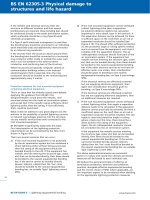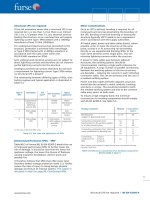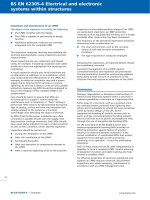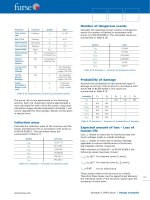Bsi bs en 00568 2015
Bạn đang xem bản rút gọn của tài liệu. Xem và tải ngay bản đầy đủ của tài liệu tại đây (1.07 MB, 20 trang )
BS EN 568:2015
BSI Standards Publication
Mountaineering equipment
— Ice anchors — Safety
requirements and test methods
BS EN 568:2015
BRITISH STANDARD
National foreword
This British Standard is the UK implementation of EN 568:2015.
It supersedes BS EN 568:2007 which is withdrawn.
The UK participation in its preparation was entrusted to Technical
Committee SW/136/5, Sports, Playground and other Recreational
Equipment - Mountaineering Equipment.
A list of organizations represented on this committee can be
obtained on request to its secretary.
This publication does not purport to include all the necessary
provisions of a contract. Users are responsible for its correct
application.
© The British Standards Institution 2015.
Published by BSI Standards Limited 2015
ISBN 978 0 580 86286 1
ICS 97.220.40
Compliance with a British Standard cannot confer immunity from
legal obligations.
This British Standard was published under the authority of the
Standards Policy and Strategy Committee on 30 November 2015.
Amendments/corrigenda issued since publication
Date
Text affected
BS EN 568:2015
EN 568
EUROPEAN STANDARD
NORME EUROPÉENNE
EUROPÄISCHE NORM
November 2015
ICS 97.220.40
Supersedes EN 568:2007
English Version
Mountaineering equipment - Ice anchors - Safety
requirements and test methods
Équipement d'alpinisme et d'escalade - Broches à glace
- Exigences de sécurité et méthodes d'essai
Bergsteigerausrüstung - Verankerungsmittel im Eis Sicherheitstechnische Anforderungen und
Prüfverfahren
This European Standard was approved by CEN on 26 September 2015.
CEN members are bound to comply with the CEN/CENELEC Internal Regulations which stipulate the conditions for giving this
European Standard the status of a national standard without any alteration. Up-to-date lists and bibliographical references
concerning such national standards may be obtained on application to the CEN-CENELEC Management Centre or to any CEN
member.
This European Standard exists in three official versions (English, French, German). A version in any other language made by
translation under the responsibility of a CEN member into its own language and notified to the CEN-CENELEC Management
Centre has the same status as the official versions.
CEN members are the national standards bodies of Austria, Belgium, Bulgaria, Croatia, Cyprus, Czech Republic, Denmark, Estonia,
Finland, Former Yugoslav Republic of Macedonia, France, Germany, Greece, Hungary, Iceland, Ireland, Italy, Latvia, Lithuania,
Luxembourg, Malta, Netherlands, Norway, Poland, Portugal, Romania, Slovakia, Slovenia, Spain, Sweden, Switzerland, Turkey and
United Kingdom.
EUROPEAN COMMITTEE FOR STANDARDIZATION
COMITÉ EUROPÉEN DE NORMALISATION
EUROPÄISCHES KOMITEE FÜR NORMUNG
CEN-CENELEC Management Centre: Avenue Marnix 17, B-1000 Brussels
© 2015 CEN
All rights of exploitation in any form and by any means reserved
worldwide for CEN national Members.
Ref. No. EN 568:2015 E
BS EN 568:2015
EN 568:2015 (E)
Contents
Page
European foreword....................................................................................................................................................... 3
Introduction .................................................................................................................................................................... 4
1
Scope .................................................................................................................................................................... 5
2
Normative references .................................................................................................................................... 5
3
Terms and definitions ................................................................................................................................... 5
4
4.1
4.2
4.3
4.4
4.4.1
4.4.2
Safety requirements ....................................................................................................................................... 5
Design .................................................................................................................................................................. 5
Resistance to hammering of ice pitons.................................................................................................... 6
Screwability of the ice screws ..................................................................................................................... 6
Holding strength .............................................................................................................................................. 6
Holding strength in the radial direction ................................................................................................. 6
Holding strength in the axial direction ................................................................................................... 6
5
5.1
5.2
5.2.1
5.2.2
5.2.3
5.2.4
Test methods .................................................................................................................................................... 7
Examination of design ................................................................................................................................... 7
Determination of screwability of the ice screws and resistance to fracture and
holding force of ice anchors ........................................................................................................................ 7
Test samples ..................................................................................................................................................... 7
Apparatus........................................................................................................................................................... 7
Preparation of the test block ...................................................................................................................... 8
Procedure........................................................................................................................................................... 9
6
Marking ............................................................................................................................................................ 11
7
Information supplied by the manufacturer........................................................................................ 12
Annex A (informative) Standards on mountaineering equipment ......................................................... 13
Annex ZA (informative) Relationship between this European Standard and the Essential
Requirements of EU Directive 89/686/EEC........................................................................................ 14
Bibliography ................................................................................................................................................................. 15
2
BS EN 568:2015
EN 568:2015 (E)
European foreword
This document (EN 568:2015) has been prepared by Technical Committee CEN/TC 136 “Sports,
playground and other recreational facilities and equipment”, the secretariat of which is held by DIN.
This European Standard shall be given the status of a national standard, either by publication of an
identical text or by endorsement, at the latest by May 2016, and conflicting national standards shall be
withdrawn at the latest by May 2016.
Attention is drawn to the possibility that some of the elements of this document may be the subject of
patent rights. CEN [and/or CENELEC] shall not be held responsible for identifying any or all such patent
rights.
This document has been prepared under a mandate given to CEN by the European Commission and the
European Free Trade Association, and supports essential requirements of EU Directive(s).
For relationship with EU Directive, see informative Annex ZA, which is an integral part of this
document.
This document supersedes EN 568:2007.
In comparison with the previous edition, the following major changes were made:
a) now included: the option of using cellular concrete in holding strength test instead of ice type 2;
b) clarification of figures.
According to the CEN/CENELEC Internal Regulations, the national standards organizations of the
following countries are bound to implement this European Standard: Austria, Belgium, Bulgaria,
Croatia, Cyprus, Czech Republic, Denmark, Estonia, Finland, Former Yugoslav Republic of Macedonia,
France, Germany, Greece, Hungary, Iceland, Ireland, Italy, Latvia, Lithuania, Luxembourg, Malta,
Netherlands, Norway, Poland, Portugal, Romania, Slovakia, Slovenia, Spain, Sweden, Switzerland,
Turkey and the United Kingdom.
3
BS EN 568:2015
EN 568:2015 (E)
Introduction
The text of this European Standard is based on the former UIAA-Standard Q "ice anchors" (Union
Internationale des Associations d'Alpinisme), which has been developed with international
participation.
This European Standard is one of a package of standards for mountaineering equipment (see Annex A).
4
BS EN 568:2015
EN 568:2015 (E)
1 Scope
This European Standard specifies safety requirements and test methods for ice anchors, i.e. ice screws
and ice pitons for use in mountaineering including climbing.
2 Normative references
The following documents, in whole or in part, are normatively referenced in this document and are
indispensable for its application. For dated references, only the edition cited applies. For undated
references, the latest edition of the referenced document (including any amendments) applies.
EN 566, Mountaineering equipment — Slings — Safety requirements and test methods
3 Terms and definitions
For the purposes of this document, the following terms and definitions apply.
3.1
ice anchor
general term for ice screws and ice pitons
3.2
ice screw
anchor which is screwed into the ice and is screwed out again after use
3.3
ice piton
anchor which is hammered into the ice and is removed again after use
3.4
placement length
l
length of the anchor from its end to the part of the eye/connector hole intended to be in contact with
the ice after it has been screwed or hammered in
Note 1 to entry:
See Figure 1.
Figure 1 — Placement length, l
4 Safety requirements
4.1 Design
4.1.1 Ice screws shall consist of a cylindrical or semi-cylindrical hollow body with thread. At the
screw head, there is an eye into which a connector can be clipped.
Ice pitons shall consist of a cylindrical or semi-cylindrical hollow body and have an eye into which a
connector can be clipped.
5
BS EN 568:2015
EN 568:2015 (E)
4.1.2
The head and the eye shall be free from burr and sharp edges.
The internal edges of the eye shall be rounded with a radius larger than 0,2 mm or have a chamfer
larger than 0,2 mm × 45°. See a) in Figure 2.
Dimensions in millimetres
a)
b)
Figure 2 — Attachment point eye dimensions
4.1.3 When tested according to 5.1, the eye shall have an internal diameter of at least 15 mm. See b) in
Figure 2.
4.2 Resistance to hammering of ice pitons
When tested in accordance with 5.2.4.1, ice pitons shall not show any deformation likely to affect safety,
e.g. cracks or separation of components. The impact area of the head shall remain sufficiently intact so
as to allow further hammering.
NOTE
Deformation due to hammering, as occurs with chisels, is not considered detrimental.
If the ice anchor has a sling for attachment, which is removable without tools, the sling shall conform to
EN 566.
4.3 Screwability of the ice screws
When tested in accordance with 5.2.4.2 after a maximum of 10 full rotations of the ice screw the
penetration of the following rotation shall be equal to the pitch of the thread of the ice screw.
4.4 Holding strength
4.4.1 Holding strength in the radial direction
When tested in accordance with 5.2.4.3.1, anchors shall withstand a force of at least 10 kN in the radial
direction, without being pulled out of the ice or breaking.
Permanent deformation during the test is permitted.
4.4.2 Holding strength in the axial direction
When tested in the axial direction in accordance with 5.2.4.3.2, ice anchors shall withstand a force of at
least 5 kN without the hanger breaking or becoming detached.
All test samples shall meet the requirement.
6
BS EN 568:2015
EN 568:2015 (E)
5 Test methods
5.1 Examination of design
Test the requirements specified in 4.1 by tactile and visual examination and measurement.
5.2 Determination of screwability of the ice screws and resistance to fracture and
holding force of ice anchors
5.2.1 Test samples
Carry out the test on four ice screws or four ice pitons according to Table 1.
Table 1 — Number of test samples
Type of ice anchor
Ice piton
a
b
Ice screw
Number of samples for testing according to
5.2.4.1
5.2.4.2
5.2.4.3.1
5.2.4.3.2
1
b
(largest length)
0
3
(shortest length)b
0
0
1
a
3
b
(shortest length)
After being tested according to 5.2.4.2, the ice screw is used for the test according to 5.2.4.3.2.
1
If anchors of different length, but otherwise same design, are available.
5.2.2 Apparatus
5.2.2.1
5.2.2.2
Ice blocks.
Steel ice container of the following dimensions:
minimum length
minimum width
minimum depth
minimum wall thickness
350 mm
220 mm
330 mm
6 mm
internal dimensions
The base of the ice container shall be rigid so that it does not influence the test results.
5.2.2.3
A vertically guided falling body of mass (10 ± 0,02) kg with a flat impact area of 30 mm
(± 10) mm diameter of hardness, HV (40) = (800 ± 10) %.
5.2.2.4
A device as shown in Figure 3 to hold a shaft at right angles to the ice surface, the lower end
of the shaft having a clamping mechanism for an ice screw, which holds the screw concentrically. A
lever is fitted to the top of the shaft for screwing in the ice screw.
7
BS EN 568:2015
EN 568:2015 (E)
Key
1 rotary shaft
2 guide
3 radial clamp
4 ice
Figure 3 — Device for testing the screwability of ice screws
5.2.3 Preparation of the test block
5.2.3.1
Type 1: Fill the ice container with potable water and store it at (– 10 ± 1) °C for at least 20 h.
Smooth off any uneven surface of the ice.
5.2.3.2
Type 2: Fill the ice container alternately 50 mm deep with layers of ice grains with a
maximum diameter of 10 mm and 250 ml of cold potable water and store it at (– 8 ± 2) °C, for at least
20 h. When the ice container is full, load the ice for (5 ± 0,5) min with a steel plate of mass (100 ± 2) kg,
the clearance between the steel plate and the side walls of the container not exceeding 10 mm. The ice
block shall be used immediately for testing according to 5.2.4.3.1.
The block of ice type 2 can be alternatively replaced by a block of cellular concrete with following
characteristics:
— Material: cellular concrete
— Density: 500 kg/m3 (± 50) kg/m3
— Compressive strength: 4 MPa ± 0,25 MPa
— Minimum dimensions: Width: 200 mm, Height: 400 mm, Depth: 250 mm
8
BS EN 568:2015
EN 568:2015 (E)
— High, low, left and right faces have to be held with metal plates to avoid cracks
— The temperature treatment for the test has to be analogue to ice type 2
5.2.4 Procedure
5.2.4.1 Determination of resistance of ice pitons when hammered in
Carry out the test at (– 10 ± 3) °C. Drive the ice piton into an ice block of type 1, using a vertically guided
falling body. Ensure that the ice surface is horizontal and that the ice piton is within 1° of vertical before
the first drop.
For the first impact, fix the drop height at (375 ± 5) mm above the impact surface of the ice piton.
For each successive impact, increase the drop height by the amount the piton has penetrated the ice.
Hammer in the ice piton until the lower edge of the eye is in contact with the surface of the ice.
Repeat the procedure, inserting and pulling out the piton slowly from the ice 100 times, without
removing the ice core between the individual placements.
The piton may be placed in the same ice block several times, providing the placements are at least 75
mm apart from each other and from the edges.
5.2.4.2 Determination of screwability of ice screws
Fix the ice screw concentrically to the shaft of the holding device by means of the clamp. Store the ice
screw and test device at (– 10 ± 1) °C for a minimum of 4 h.
Place the ice screw on the surface of a type 1 ice block and adjust the holding device to keep the ice
screw at right angle to the ice surface.
Screw in the ice screw with a continuous contact force of (120 ± 3) N.
After a maximum of 10 turns check that the requirements specified in 4.3 are met.
Complete the test within 5 min of removal from the conditioning atmosphere.
5.2.4.3 Determination of holding strength of ice anchors
5.2.4.3.1 Testing in radial direction
Testing shall be carried out at a room temperature of (23 ± 5) °C.
Insert the ice anchor as specified in the information supplied by the manufacturer, in the middle of the
surface of a type 2 ice container prepared as described in 5.2.3.2 at an angle of (90 ± 5)°. If the ice block
is used smooth the ice surface around the anchor and store the ice block and test sample at (– 18 ± 1) °C
for 20 h.
Apply a load by means of a (10 ± 0,1) mm steel bar placed in the eye of the hanger of the ice anchor, as
specified in the information supplied by the manufacturer, parallel to the ice surface (see Figure 4), at a
rate of (100 ± 10) mm/s until the ice anchor fails or is pulled out of the ice block or cellular concrete
block. Complete the test within 3 min of removal from the conditioning atmosphere.
9
BS EN 568:2015
EN 568:2015 (E)
Figure 4 — Test for the holding force
5.2.4.3.2 Testing in axial direction
Testing shall be carried out at a room temperature of (23 ± 5) °C.
Clamp the test sample in shaped metal jaws as shown in the left side of Figure 5. The edge of the jaws
shall be (25 ± 1) mm from the part of the ice anchor hanger that touches the ice when fully inserted.
Ensure that the body of the test sample is held rigidly without deformation that could affect the
attachment of the hanger to the body of the test sample. If necessary, an internal support may be used
but this support shall not extend to within 25 mm of the outer edge of the jaw. Where the edge of the
jaw comes into contact with the test sample, the edge shall have a radius of (5 ± 0,5) mm. If required the
jaw and test sample may be drilled and pinned to restrain the body of the test sample.
Connect the eye of the hanger to the jaw of the test machine using a metal link with a universal joint or a
flexible metal link of length (200 ± 10) mm, as shown in the right side of Figure 5. Apply a force to the
test sample using a test speed of 20 mm/min to 50 mm/min. Increase the force to 5 kN.
10
BS EN 568:2015
EN 568:2015 (E)
Dimensions in millimetres
Key:
1 jaw
2 hanger
3 metal link
Figure 5 — Testing in axial direction
6 Marking
The body or the eyes of the ice anchors shall be marked clearly, indelibly and durably with at least the
following:
a) name of the manufacturer or his/ her authorized representative;
NOTE
For a definition of manufacturer and authorized representative, see Regulation 765/2008 [1].
b) model identifier (if several models are marketed by the manufacturer);
c) graphical symbol (see Figure 6), which advises the user to read the information given by the
manufacturer:
Figure 6 — Graphical symbol (according to ISO 7000, Symbol No. 1641)
11
BS EN 568:2015
EN 568:2015 (E)
d) If the ice anchor is fitted with a non-metallic load bearing element the year of manufacture shall be
present on the element.
7 Information supplied by the manufacturer
The information supplied by the manufacturer shall contain at least the following items:
a) name and address of the manufacturer or its authorized representative [1];
b) reference of this European Standard, i.e. EN 568;
c) the meaning of any markings on the product;
d) the use of the product:
1) how to choose other components for use in the system;
2) how to insert and extract the ice anchor;
3) how to check the ice anchor to ensure safe further use;
4) where and how to attach to the ice anchor.
e) how to maintain and service the product;
f)
the lifespan of the product and factors affecting the lifespan;
g) advice that the product shall only be used by trained and/or otherwise competent persons or the
user should be under the direct supervision of a trained and/or otherwise competent persons;
h) effects of chemical reagents and temperature on the product;
i)
j)
conditions of storage;
ice pitons shall not be placed in such a position that they will be loaded in an axial direction (only
for ice pitons);
k) placement length (l).
12
BS EN 568:2015
EN 568:2015 (E)
Annex A
(informative)
Standards on mountaineering equipment
Table A.1 — List of standards on mountaineering equipment
No
Document
Title
1
EN 892
Mountaineering equipment — Dynamic mountaineering ropes — Safety requirements
and test methods
3
EN 13089
Mountaineering equipment — Ice-tools — Safety requirements and test methods
2
4
5
6
7
8
9
10
11
12
13
14
15
16
17
18
19
EN 12275
EN 12277
EN 12492
EN 564
EN 565
EN 566
EN 12276
EN 12270
EN 567
EN 958
EN 959
EN 568
EN 569
EN 893
EN 15151-1
EN 15151-2
EN 12278
Mountaineering equipment — Connectors — Safety requirements and test methods
Mountaineering equipment — Harnesses — Safety requirements and test methods
Mountaineering equipment — Helmets for mountaineers — Safety requirements and test
methods
Mountaineering equipment — Accessory cord — Safety requirements and test methods
Mountaineering equipment — Tape — Safety requirements and test methods
Mountaineering equipment — Slings — Safety requirements and test methods
Mountaineering equipment — Frictional anchors — Safety requirements and test
methods
Mountaineering equipment — Chocks — Safety requirements and test methods
Mountaineering equipment — Rope clamps — Safety requirements and test methods
Mountaineering equipment — Energy absorbing systems for use in klettersteig (via
ferrata) climbing — Safety requirements and test methods
Mountaineering equipment — Rock anchors — Safety requirements and test methods
Mountaineering equipment — Ice anchors — Safety requirements and test methods
Mountaineering equipment — Pitons — Safety requirements and test methods
Mountaineering equipment — Crampons — Safety requirements and test methods
Mountaineering equipment — Braking devices — Part 1: Braking devices with manually
assisted locking, safety requirements and test methods
Mountaineering equipment — Braking devices — Part 2: Manual braking devices, safety
requirements and test methods
Mountaineering equipment — Pulleys — Safety requirements and test methods
13
BS EN 568:2015
EN 568:2015 (E)
Annex ZA
(informative)
Relationship between this European Standard and the Essential
Requirements of EU Directive 89/686/EEC
This European Standard has been prepared under a mandate given to CEN by the European
Commission and the European Free Trade Association to provide a means of conforming to Essential
Requirements of the New Approach Directive 89/686/EEC on the approximation of the laws of the
Member States relating to personal protective equipment.
Once this standard is cited in the Official Journal of the European Union under that Directive and has
been implemented as a national standard in at least one Member State, compliance with the clauses of
this standard given in Table ZA.1 confers, within the limits of the scope of this standard, a presumption
of conformity with the corresponding Essential Requirements of that Directive and associated EFTA
regulations.
Table ZA.1 — Correspondence between this European Standard and Directive 89/686/EEC
Clause(s)/subclause(s)
of this EN
Essential Requirements (ERs) of Directive 89/686/EEC
4.1.2
1.2.1.2 Satisfactory surface condition of all PPE parts in
contact with the user
4.4
3.1.2.2 Prevention against falling from heights
4.2, 4.3 and 4.4
Clause 7
1.3.2
1.4
Lightness and design strength
Information supplied by the manufacturer
Qualifying remarks/
Notes
Ice anchors according to
this standard are only
one part of the safety
chain and should be used
in conjunction with
other
compatible
equipment.
WARNING — Other requirements and other EU Directives may be applicable to the product(s) falling
within the scope of this standard.
14
BS EN 568:2015
EN 568:2015 (E)
Bibliography
[1]
Regulation 765/2008 OF THE EUROPEAN PARLIAMENT AND OF THE COUNCIL of 9 July 2008
setting out the requirements for accreditation and market surveillance relating to the marketing
of products and repealing Regulation (EEC) No 339/93
15
This page deliberately left blank









